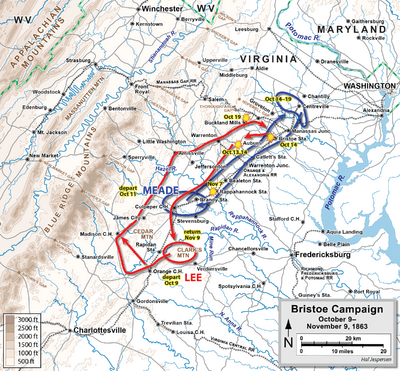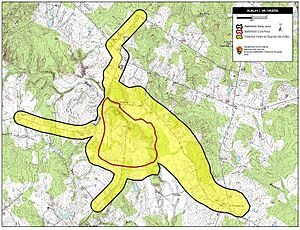First Battle of Auburn facts for kids
Quick facts for kids First Battle of Auburn |
|||||||
|---|---|---|---|---|---|---|---|
| Part of the American Civil War | |||||||
|
|||||||
| Belligerents | |||||||
| Commanders and leaders | |||||||
| William H. French | J.E.B. Stuart | ||||||
| Strength | |||||||
| 2,000 | 3,000 | ||||||
| Casualties and losses | |||||||
| 50 | |||||||
The First Battle of Auburn happened on October 13, 1863. It was a small but important fight during the American Civil War. Soldiers from the Union Army and Confederate States Army clashed. This battle kicked off the Bristoe Campaign. A group of Union soldiers accidentally ran into Confederate cavalry (soldiers on horseback). A quick fight happened, but neither side really won. The Confederates pulled back because the Union forces were stronger. However, a larger group of Confederate cavalry, led by J.E.B. Stuart, got stuck. They were trying to attack a Union supply train but ended up hiding in a ravine all night. They waited for their fellow Confederate soldiers to come help them.
Why Did the Battle Happen?
After the big Battle of Gettysburg, both the Confederate and Union armies needed to rest and get new supplies. They were camped on opposite sides of the Rapidan River in Virginia. For a few months, not much happened.
Then, in early September, a Confederate general named James Longstreet took some of his troops to help in another part of the war. After a Confederate victory there, the Union general, George Meade, had to send some of his own troops away too. When Confederate General Robert E. Lee found out about this, he decided it was a good time to attack. He wanted to pick the battlefield himself.
Lee's plan was similar to one he used before. He wanted to go around the Union army's right side and threaten Washington, D.C.. This would force the Union army to fight him. Confederate generals Richard Ewell and A. P. Hill were ordered to march around the Union side. General Fitzhugh Lee was to protect the Rapidan River. And General J.E.B. Stuart was to lead the cavalry ahead of the main army.
The Confederate attack started on October 8. Union spies and signal stations quickly found out about it. General Meade wasn't sure if Lee was trying to go around his army or retreat toward Richmond, Virginia. So, Meade prepared for both possibilities.
On October 10, Stuart made a fake attack to distract the Union forces. This made Meade believe Lee wasn't retreating. So, Meade moved his army to block Lee's path. On October 12, Union soldiers saw Confederate infantry. This made Meade think Lee was going to use a specific mountain pass, like he did in 1862. Meade then pulled his army back toward Centreville, Virginia to protect Washington. But Lee actually planned to go to Warrenton, Virginia, staying south of the mountains. On October 13, Stuart was sent to find out where the Union army's left side was as they moved back.
The Fight at Auburn
At 10:00 AM on October 13, General Stuart sent one of his brigades, led by Lunsford L. Lomax, east from Warrenton. Stuart followed an hour later with two more brigades. Lomax stopped at Auburn to wait for Stuart. He sent scouts further east, and they found Union cavalry guarding a large supply train.
However, no scouts were sent south. This was a big mistake. Two large Union army groups, the II and III Corps, were marching north toward Auburn. They had gotten separated from the main Union army due to confusion.
Stuart arrived at Auburn around 1:00 PM. He then rode east to check out the Union supply train. He left Lomax to hold Auburn. Stuart was very impressed by how big the supply train was. He sent a message to General Fitzhugh Lee, asking him to help attack it. Lee left Warrenton at 4:00 PM and followed Stuart's path through Auburn.
Around 4:15 PM, the Union column, led by General William H. French's III Corps, came close to Auburn. French had sent his own cavalry ahead to protect his left side. This meant his main column had no cavalry at its front. So, they walked right into the Confederates at Auburn without knowing.
General French and his officers at the front of the column started firing their pistols at the Confederates. Union infantry and artillery quickly moved up. Lomax tried to charge the Union line, but a blast of cannon fire pushed his attack back. By 4:45 PM, the fighting stopped. Just then, Fitzhugh Lee arrived. When they saw they were facing two large Union infantry groups, Lee and Lomax decided to pull back to Warrenton.
What Happened Next?
This short battle only caused about 50 injuries in total. But it had a big impact on General Stuart and the rest of the campaign. Stuart soon learned that he was trapped. The Union II and III Corps were to his northwest, and the big Union supply train was to his southeast.
Stuart led his entire command – about 3,000 men and horses, five supply wagons, and seven cannons – into a hidden, wooded ravine. This ravine was only about 300 meters from where the Union soldiers were camping for the night. After dark, Stuart sent six scouts, dressed in Union uniforms, through the Union lines. Their mission was to tell General Robert E. Lee what had happened.
Lee got the message and immediately sent General Ewell's troops to Auburn at dawn to rescue Stuart and his cavalry. This setup the stage for the Second Battle of Auburn the very next day.
Images for kids





